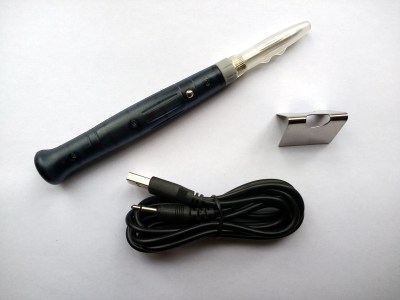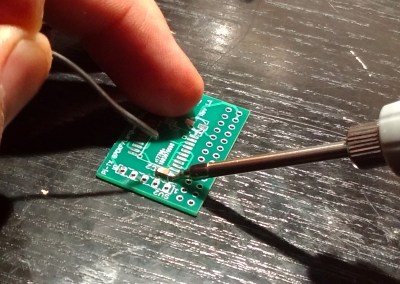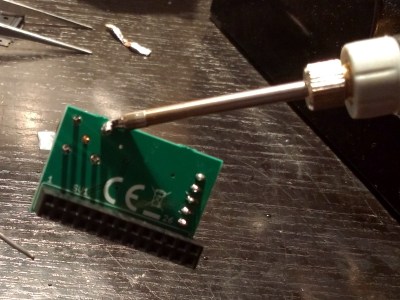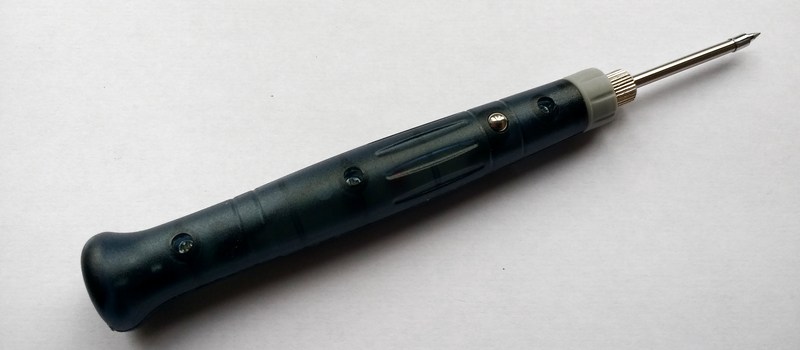When it comes to soldering irons, most of us are likely to be in agreement that there is a level of quality below which we will not descend. To do a decent job requires a decent tool, and when it comes to soldering that means a good quality temperature controlled iron with a decent power level and a quality bit. Anything else just isn’t worth considering.
But what if you look at it from the opposite angle? When it comes to soldering, just how low can you go? In that case probably the ultimate scraping of the soldering barrel comes courtesy of USB soldering irons, taking their juice from a five volt phone charger socket and providing tiny power levels you’d expect to be barely enough to work at all. Surely these are toys, not irons!
Recently I was making an order with your favourite purveyor of electronic bits and pieces from China, and since a USB soldering iron came up on my screen for only £3.69 ($4.76) my curiosity was piqued enough to tack it onto the end of my list of other items.

The postal services of the world are masters of building anticipation, so it was the usual three weeks before a little parcel arrived from the other side of the world. In it alongside the various modules that were the main focus of my order was the subject of this review. An Aneng LT-001 Professional 8 W USB soldering iron, in a clear plastic display carton with a cardboard insert. It’s worth pointing out that very similar irons are available under many different brands, this one can be taken as a representative example.
Unpacking the iron, in front of me was a USB-to-3.5mm power cable, a rather laughable little metal stand, and the iron itself with a protective plastic cap. This weighs only 22 g, or 0.77 oz, and is about 190 mm or 6.5″ long, of which only 45 mm or 1.75″ is the very slim element and bit. The rest is a semi-transparent plastic handle with a single button to activate the iron. Once activated, there is a visible red LED inside the handle to indicate that the iron is on. The packaging claims that the bit can be replaced, however I didn’t find replacement bits for sale and looking at the price for a new iron it’s questionable why you’d want to.
A USB Iron In Use

To test the iron, I plugged the 3.5 mm plug into the socket on its base, and the USB plug on the other end of the cable into my Anker multi-port USB power brick, as it would demand too much power from a PC USB port. I then took a simple electronic kit, an abandoned development product for my kit business, and set to work to put the iron through its paces.
In the first instance, with surface-mount discrete components, this iron was a joy to use. Its meagre power level was not sapped by the heat capacity of the miniscule parts, the tiny bit was just the perfect size, and the iron’s extremely light weight and short length of the element made it very easy to get into the action. In this limited arena this iron was considerably better than some far more expensive irons that possess significant bulk.

Then soldering an SOIC, the lack of power showed itself in being unable to perform in one of the ways a more hefty iron could. Often you will make solder bridges between SOIC pins, and these you will remove with a bit of desoldering braid. Doing this in the normal manner simply sucked the heat away from the USB iron, and required a rescue with a conventional iron. Returning to the other side of the same chip I evolved a technique of soldering each pin with considerably more care, and wicking away the only solder bridge I had with the very end of my braid to minimise heat loss. In this way I was able to desolder with the USB iron, but it was by no means an easy process.
The kit in question has a few 0.1″ pitch through-hole connectors, and the USB iron coped well with these even when the pins were connected to through-plated groundplanes on both sides. It’s possible that it could store enough heat in the pin to allow the solder to attach properly to the through plating before the groundplane sucked too much of it away.

The final component though was a different story, a through-hole BNC socket. Here the main deficiency of the iron showed itself, as the sheer mass of the socket was enough to suck away every joule the little iron could deliver. Eventually I ended up with the USB iron still powered up and soldered fast to the BNC socket, which was not soldered to the board. No doubt if I had waited long enough the whole piece would have come up to solder melting temperature, but probably at the expense of harm to the other components. Thus I rescued it by desoldering the USB iron from the BNC socket with my mains-powered iron, something I can honestly say I’ve never done before.
A Toy, But Not a Joke
So, given that I’ve taken what amounts to a toy and subjected it to a serious review, what’s the verdict?
The first and most obvious conclusion is this: A USB iron is not and never will be a replacement for your conventional iron. With only 8 W on offer there will always come a point at which a soldering job is too much for it, and it will not be able to melt the solder in the face of heat loss.
That said, there are lighter soldering jobs, particularly those involving small surface mount discrete components, in which a USB iron can give a good account of itself, both in terms of heat output and in terms of small size and weight. Yet again it will never be a replacement for a high-end lightweight temperature-controlled iron, but in this arena it can at least do the job rather well.
Would I suggest that you buy one? Given that you can have one of these for relative pennies, I’d say if you are making an order anyway, then yes. But if you are buying one in the expectation that it will deliver the same performance as a mains-powered iron, then definitely not.
My iron will stay in my tool kit, after all there may be times I need to do some especially fiddly surface-mount work when the only power I have us a USB battery bank. It will remain a toy, but after having spent an afternoon using it I can at least say it will not entirely be a joke.















I have a handful of those (they are so damn cheap) and i put them everywhere. Just perfect for the fast soldering job on the fly. Not for any bigger job or big ground planes but it’s perfectly adequate for many small jobs. Often I use it even if I’m near my soldering station because it’s so nimble. With a powerbank it’s the perfect traveling companion.
This looks pretty much identical to the one reviewed here https://hackaday.com/2016/04/25/usb-soldering-iron-is-surprisingly-capable/ and I bought one after watching Big Clive’s video – now I have one in every bag they are very very useful and work great.
Completely agree! I also have a bunch of these. Sure, they wouldn’t replace a real soldering, but at the price of about 5USD, it’s really awesome. It’s a great travel iron for field work.
When I read the title, I wondered if there had come something new that was better than the TS-100 featured a few weeks ago. Fortunately not, because I’ve just got used to the TS-100 and my old Weller sees very little use anymore.
I suppose it’s a better price, but fortunately not :)
Have to agree, my TS-100 has quickly become my iron of choice. It heats up faster than my Aoyue and it’s far more portable. I’m considering finding a way to integrate a power supply into my workbench actually.
I’ve become attached to my Bakon 950D iron. I’ve purchased two (as low a $24 shipped from usual China sources) and have two others for field techs where I work. It takes Hakko T12 cartridge tips, which are also cheap and plentiful and offers variable heat with six presets. Very portable and compares favorably with a Metcal station (except no idle setting). Only available with a 220V (Korea?) plug, so plug replacement is needed in the US. A really solid solution with an array of tips for under $50.
Mine came with a schuko (european) plug on it (nothing that a good – earthed, unlike the supplied death-dapter – euro-to-UK converter couldn’t solve), but at least one chinese tat purveyor lists the 950D with a 110V US plug option, too.
I’ve been very tempted by the Bakon. Do you happen to know the “grip to tip” distance measurement? It looks like 3-4cm from photos online, which is far better than anything else sub $300.
The one I have is about 45mm from the front of the grip to the tip end. The field techs in the lab received tips that were about half again longer (not sure why), but for what they do, it works for them.
I have this and TS100, TS100 is way better, but this little iron is suprisely good when you are in need :) I wrote something (in czech sorry) here: mikrom.cz/nova-pajka-ts100/
compare both irons
https://www.mikrom.cz/wp-content/uploads/2017/08/ts100_porovnani.jpg
The TS100 is nice, yes, but it’s not USB powered, so it’s not really a fair comparison
replacement tips are available on ebay: http://www.ebay.com/itm/Replacement-Soldering-Iron-Tip-for-USB-Powered-Mini-5V-8W-Electric-Soldering-/122617390253?hash=item1c8c90e4ad:g:WyUAAOSwZQRYYilz
I bought it after seeing bigclive’s video, that little soldering iron performs suprisingly good. Ofcourse you can’t compare it with 10x more expensive irons or 24V/48V/220V irons, but for quick desoldering or repair jobs on SMD elements it works very good. You must have good power source, if you plug it in some crappy “2.4A” powerbank that gives actual 1A then it won’t work fine.
I bought one after it was reviewed by BigClive: https://www.youtube.com/watch?v=o-8D5t6TJYU
It’s actually brilliant if you’re like me and have very limited space and want to quickly whip stuff up or just to 10 mins work on your project
Every tool has a right way and a wrong way to use it.
Part of the right way is knowing the limits of your tool.
I have been using these little soldering irons for “OH God” form the early 70’s.
And small cordless drills as well. I got my first soldering iron in a surprise box from Radio Shack.
And come to think of it my first cordless drill as well. Oh how I loved getting those surprise boxes.
I found that a 1/3 of the time it would be junk, But when you did get something good it was always more then one thing. I some how almost always got great stuff. Or at least I thought so.
I have always loved them for there light weight and ease of use. And you could use it almost anywhere.
I’ve just received a 12v soldering iron, haven’t tried it yet but I’m hoping it will give good account of itself.
So far, it seems that a USB-powered iron would not be useful for me; too underpowered, and if it requires a hi-current USB wall-wart, then why am I not using a conventional 120 VAC iron? My old eyeballs won’t be doing any surface-mount work without a big heavy magnifying glass and halogen lights, so that pretty much limits me to an equipped bench.
I’ve got a 10+ year old Black & Decker portable soldering iron that uses the same butane power cells as curling irons. It packs the heat of a 25w but is 100% portable.
I was wondering.. there are many vape boxes and mods.
Whats the chance of making a tank that takes replacement solder tips?
Good idea or not?
I don’t see why it would be a problem, but you need a way to measure temperature. On vaporizers, the fully featured boxes that can read temperature (or set the desired temperature) use a special coil that has nickel in it. It’s just reading the resistance and setting the wattage based on how hot the user wants it. Rather than modifying a box, just build one! I have personally considered using an 18650, a DC converter, microcontroller, OLED screen, and temperature sensor to create a rechargeable iron that’s capable of putting out up to 50 watts, and maintaining a temperature. It would be pretty tough to cram all of that into a cylinder shaped body but I think it’d be worth it for portable use. Imagine being able to have a small bag with some solder, braid, a flux pen, tweezers, the iron, and a USB cable with charging brick. I have never searched to see if any products are available like that, but I would buy one if they already do.
most of them use the same chip and there is open source firmware too.
i could add it as a feature
https://github.com/ClockSelect/myevic
The one i posted supports Joyetech
eVic VTC Mini
eVic VTC Dual
eVic VTwo Mini
eVic VTwo
eVic AIO
eVic Basic
eGrip II / Light
Cuboid
Cuboid Mini
Cuboid 200
Wismec
Presa TC75W
Presa TC100W
Reuleaux RX75
Reuleaux RX200S
Reuleaux RX2/3
Reuleaux RXmini
Reuleaux RX300
the bigger 200W and up mods should be able to do this easily
So all you would need is the tank like adapter that accepts a quality respected solder tip.
Like this?
https://www.banggood.com/Original-Replacement-Solder-Tip-For-TS100-Digital-LCD-Soldering-Iron-p-984215.html?rmmds=detail-top-buytogether-auto
or
This?
https://www.banggood.com/1pc-Replacement-Soldering-Iron-Tip-for-USB-Powered-Mini-5V-8W-Electric-Soldering-Iron-p-1066842.html?rmmds=search
I did not post this to advertise
You could make a soldering iron that accepts the vape battery cartridges maybe?
Assuming there is some sort of standard connection method?
Most vapes seem to use standard 18650 li-ion cells.
Most vape boxes use the same 510 thread for tanks to screw into.
So making a adapter to fit replacement soldering tips would be easy. I’m betting it would work well and be extremely cheap to get soldering if you already have a good vape mod.
A butane powered soldering iron is probably a better emergency option along that line, butane is buyable from just about anywhere that sells tobacco.
I’ve used a pair of these cheap USB irons for a year and I can only say good things about them. I’m used to expensive soldering stations which warm up in seconds and have easily exchangeable tips that are short enough to do precise jobs and still powerful enough to solder on big things. The USB iron doesnt work very well with big things but will solder most surface mount and standard through hole components just fine. Quite frankly I’ve always hated these rough entry level soldering stations with terrible iron tips where you hold your iron like 10 cm away from the tip as if you were fencing rather than writing. I think everyone praises those because of nostalgic reasons or they just don’t know any better.
I have several of these and modded them all so they stay on continuously. These irons tend to switch off when you lay them down because of the sensing switch inside that detects either movement (spring in a tube) or touching the little knob on the outside.
I also use a USB powerbank, that gives enough juice to run this little iron. It solders most components very well, especially SMD and thin wires. Because of the small form factor, you can reach places where your regular iron would have destroyed everything between entrey and goal…
A must have for every hacker. I recently repaired an electric fly catcher at work, my colleagues were stunned. By my repair, that is.
Especially if I want to repair something at work, I would not rely on such a toy. We have good quality JBC soldering stations. At home a nice SMD rework station which name is somehow similar to “AYIOU”, but I can’t remeber it, in the car a cheap crappy 30W €5 iron and sometimes the TS-100.
How about joining two together like a pair of tongs (or trainer chopsticks) for smd removal? Maybe connect the heaters in series for 12v operation if they’d stand the overcurrent for a few seconds.
I find that flooding both pads with solder and bridging the component pads with a large tip gets components off faster than tweezer type setups. Clean up the pads and/or component with solder wick and you’re ready to place the part back if needed.
Somebody did just that. We covered it. My HaD search fu is broken, I can’t find it.
This is a decent iron, at least when price and portability is of concern.
Though, not powerful enough for when it is bellow freezing, and the randomness of it suddenly turning off is a bit annoying at times. (At least the two I have at times decide to just stop heating the tip, and suddenly one have soldered the iron to the joint as well….)
But for just being 8 watts, it is able to heat up even larger joints I have found. Larger in terms of a bit more power hungry components, like larger PCB mount transformers, power regulators on a smaller heat sink, and other such fun stuff seems to work decent as well. But other annoyances can get in the way here, like PCB designers making just large enough holes for soldered components….
I bought one of these recently for pressing M3 threaded brass inserts (and things like miniature bearings) into undersized holes in 3d printed parts, and it works a treat.
Forgot to add, you can get 100 inserts like the ones I mentioned for something like $5 from Amazon and the usual sources. They’re great to have around if not already in your arsenal.
If anyone wants a good portable iron, consider gas irons (Dremel Versatip, for example) — they are really small and powerful. You don’t want to use them for sensitive little parts, but usually that’s not a job you do without a power outlet around. Another option is an ordinary 12V iron connected to a quadcopter battery. These batteries are real beasts.
Search for “USB 5V 8W soldering replacement tip” in your favorite online Asian market to get the spare tips ( http://s.click.aliexpress.com/e/IuJyfuN ) for the cheap ~USD $7 “Mini USB 8W soldering iron” (http://s.click.aliexpress.com/e/vzBq7Qr)